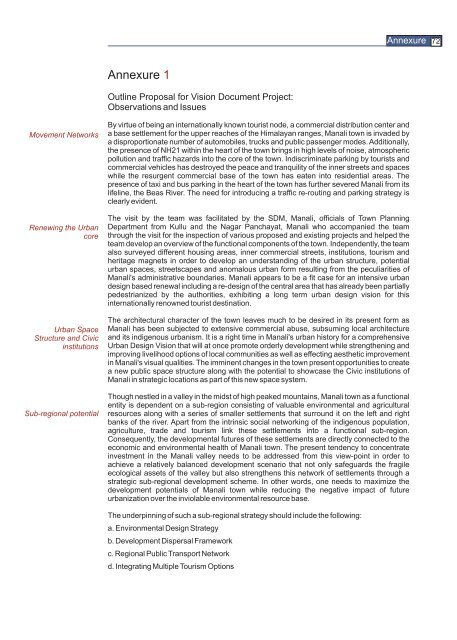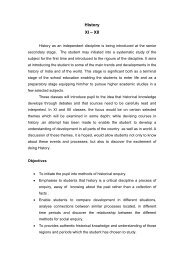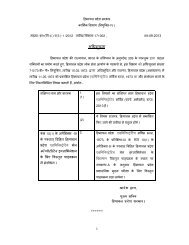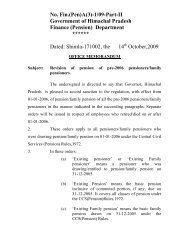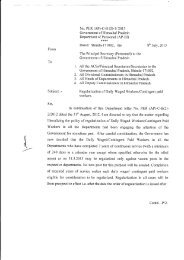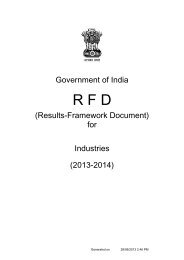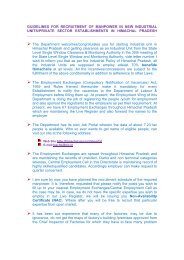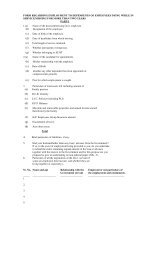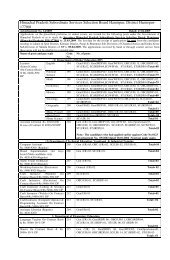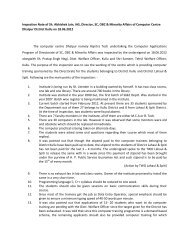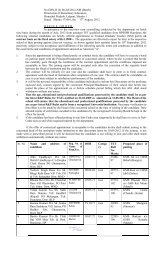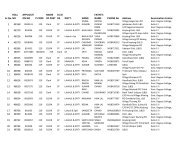Manali and its Sub-Region - Government of Himachal Pradesh
Manali and its Sub-Region - Government of Himachal Pradesh
Manali and its Sub-Region - Government of Himachal Pradesh
- No tags were found...
Create successful ePaper yourself
Turn your PDF publications into a flip-book with our unique Google optimized e-Paper software.
Annexure 72Annexure1Outline Proposal for Vision Document Project:Observations <strong>and</strong> IssuesMovement NetworksRenewing the UrbancoreUrban SpaceStructure <strong>and</strong> Civicinstitutions<strong>Sub</strong>-regional potentialBy virtue <strong>of</strong> being an internationally known tourist node, a commercial distribution center <strong>and</strong>a base settlement for the upper reaches <strong>of</strong> the Himalayan ranges, <strong>Manali</strong> town is invaded bya disproportionate number <strong>of</strong> automobiles, trucks <strong>and</strong> public passenger modes. Additionally,the presence <strong>of</strong> NH21 within the heart <strong>of</strong> the town brings in high levels <strong>of</strong> noise, atmosphericpollution <strong>and</strong> traffic hazards into the core <strong>of</strong> the town. Indiscriminate parking by tourists <strong>and</strong>commercial vehicles has destroyed the peace <strong>and</strong> tranquility <strong>of</strong> the inner streets <strong>and</strong> spaceswhile the resurgent commercial base <strong>of</strong> the town has eaten into residential areas. Thepresence <strong>of</strong> taxi <strong>and</strong> bus parking in the heart <strong>of</strong> the town has further severed <strong>Manali</strong> from <strong>its</strong>lifeline, the Beas River. The need for introducing a traffic re-routing <strong>and</strong> parking strategy isclearly evident.The visit by the team was facilitated by the SDM, <strong>Manali</strong>, <strong>of</strong>ficials <strong>of</strong> Town PlanningDepartment from Kullu <strong>and</strong> the Nagar Panchayat, <strong>Manali</strong> who accompanied the teamthrough the visit for the inspection <strong>of</strong> various proposed <strong>and</strong> existing projects <strong>and</strong> helped theteam develop an overview <strong>of</strong> the functional components <strong>of</strong> the town. Independently, the teamalso surveyed different housing areas, inner commercial streets, institutions, tourism <strong>and</strong>heritage magnets in order to develop an underst<strong>and</strong>ing <strong>of</strong> the urban structure, potentialurban spaces, streetscapes <strong>and</strong> anomalous urban form resulting from the peculiarities <strong>of</strong><strong>Manali</strong>'s administrative boundaries. <strong>Manali</strong> appears to be a fit case for an intensive urb<strong>and</strong>esign based renewal including a re-design <strong>of</strong> the central area that has already been partiallypedestrianized by the authorities, exhibiting a long term urban design vision for thisinternationally renowned tourist destination.The architectural character <strong>of</strong> the town leaves much to be desired in <strong>its</strong> present form as<strong>Manali</strong> has been subjected to extensive commercial abuse, subsuming local architecture<strong>and</strong> <strong>its</strong> indigenous urbanism. It is a right time in <strong>Manali</strong>'s urban history for a comprehensiveUrban Design Vision that will at once promote orderly development while strengthening <strong>and</strong>improving livelihood options <strong>of</strong> local communities as well as effecting aesthetic improvementin <strong>Manali</strong>'s visual qualities. The imminent changes in the town present opportunities to createa new public space structure along with the potential to showcase the Civic institutions <strong>of</strong><strong>Manali</strong> in strategic locations as part <strong>of</strong> this new space system.Though nestled in a valley in the midst <strong>of</strong> high peaked mountains, <strong>Manali</strong> town as a functionalentity is dependent on a sub-region consisting <strong>of</strong> valuable environmental <strong>and</strong> agriculturalresources along with a series <strong>of</strong> smaller settlements that surround it on the left <strong>and</strong> rightbanks <strong>of</strong> the river. Apart from the intrinsic social networking <strong>of</strong> the indigenous population,agriculture, trade <strong>and</strong> tourism link these settlements into a functional sub-region.Consequently, the developmental futures <strong>of</strong> these settlements are directly connected to theeconomic <strong>and</strong> environmental health <strong>of</strong> <strong>Manali</strong> town. The present tendency to concentrateinvestment in the <strong>Manali</strong> valley needs to be addressed from this view-point in order toachieve a relatively balanced development scenario that not only safeguards the fragileecological assets <strong>of</strong> the valley but also strengthens this network <strong>of</strong> settlements through astrategic sub-regional development scheme. In other words, one needs to maximize thedevelopment potentials <strong>of</strong> <strong>Manali</strong> town while reducing the negative impact <strong>of</strong> futureurbanization over the inviolable environmental resource base.The underpinning <strong>of</strong> such a sub-regional strategy should include the following:a. Environmental Design Strategyb. Development Dispersal Frameworkc. <strong>Region</strong>al Public Transport Networkd. Integrating Multiple Tourism Options


